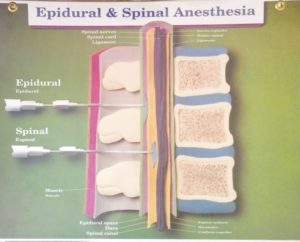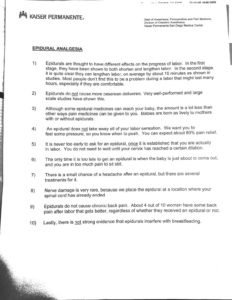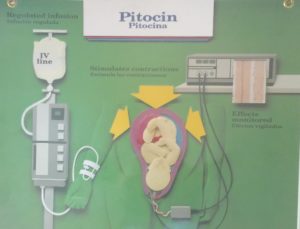 A student of mine, who took my childbirth classes and prenatal yoga classes for their first birth of twins, is expecting another baby. Kaiser Permanente is their health care provider. Her care provider gave her an official Kaiser Permanente handout on Epidural Analgesia
A student of mine, who took my childbirth classes and prenatal yoga classes for their first birth of twins, is expecting another baby. Kaiser Permanente is their health care provider. Her care provider gave her an official Kaiser Permanente handout on Epidural Analgesia that she shared with me. All care providers are required by law to give benefits and risks of all medications, tests, and procedures. But this handout doesn’t tell the whole story! I’ll address each item in separate blog posts beginning with number one.
that she shared with me. All care providers are required by law to give benefits and risks of all medications, tests, and procedures. But this handout doesn’t tell the whole story! I’ll address each item in separate blog posts beginning with number one.
“1. Epidurals are thought to have different effects on the progress of labor. In the first stage, they have been shown to both shorten and lengthen labor. In the second stage, it is quite clear they can lengthen labor, on average by about 15 minutes as shown in studies. Most people don’t find this a problem during a labor that might last many hours, especially if they are comfortable.”
FIRST STAGE RISKS AND SIDE EFFECTS
- The medication used in an epidural is considered a local anesthetic. It must be used in combination with opioids, also known as narcotics. The effects of narcotics on the baby can be:
- Central nervous system depression
- Respiratory depression (or difficulty breathing)
- Altered neurological behavior
- Impaired early breastfeeding
- According to “Does epidural analgesia increase rate of cesarean section?” Michael C. Klein, MD, CCFP, FAAP, FCFP “Contrary to the conclusion of the Cochrane meta-analysis of EA compared with narcotic analgesia, EA given before the active phase of labour more than doubles the probability of receiving a CS. If given in the active phase of labour, EA does not increase rates of CS. http://www.ncbi.nlm.nih.gov/pmc/articles/PMC1481670/
- This means that if you get an epidural before your cervix is dilated to 5-6 cm, you may be twice as likely to have a Cesarean Section.
- Epidurals decrease the Oxytocin mothers make during labor so that her uterine contractions are less effective. As a result she will need the artificial hormone, Pitocin, to stimulate and enhance her contractions.
- Pitocin can cause contractions that are much stronger, last longer, and are closer together. The baby then does not have time to recover between contractions. Then fetal distress can happen when the baby does not receive sufficient amounts of oxygen.

SECOND STAGE RISKS AND SIDE EFFECTS
- The definition of a prolonged second stage is 2-3 hours or longer. 15 minutes doesn’t sound like a lot but if you are working hard for 3 hours or longer to push your baby out, you are not going to be comfortable as the handout says. You’re going to be exhausted. http://contemporaryobgyn.modernmedicine.com/contemporary-obgyn/content/tags/delivery-complication/prolonged-second-stage-labor-may-carry-risks
- Because your contractions are less effective you may need help. That help comes in the form of instrumental delivery. This means your baby needs to be pulled out with either a vacuum extractor
 or a forceps.
or a forceps. The following risks or side effects can occur:
The following risks or side effects can occur:
- Scalp wounds causing swelling or bruising on baby’s head
- Hematoma is the formation of blood under the skin from wounding a vein or artery under the skin. The blood can seep into surrounding tissue.
- Intracranial Hemorrhage or bleeding inside the skull
- Retinal hemorrhage or bleeding in the back of baby’s eyes from the pressure placed on baby’s head from the vacuum extractor.
- Newborn Jaundice from a build up of bilirubin caused by blood leaking and causing a bruise.
Below are some additional side effects and consequences if epidurals are used:
- Epidurals inhibit the laboring mother’s body from producing adequate levels of Oxytocin – the hormone that causes contractions. When Oxytocin production is inhibited, so is her production of endorphins – the hormone that helps mother relax and naturally reduces her perception of pain.
- Epidurals tend to slow labor, which can require the additional use of another synthetic hormone, Pitocin, to increase the strength and frequency of her contractions during labor.
- There have been many studies on the risk of Cesareans as a result of the use of epidurals.Some studies concluded there is no increased risk and some studies say the risk increases by 50%. * http://sarahbuckley.com/epidurals-risks-and-concerns-for-mother-and-baby . The risk increase is more significant with a first time mother.
- Epidural anesthesia increases the risks of having an instrumental delivery – that means your baby may need to be pulled out with a vacuum extractor or forceps.
- Another possible side effect of an epidural is that the laboring mother can develop a fever. If a fever develops, it is very likely that a Cesarean will be performed. Since a fever can also possibly indicate the mother has an infection, even though it may just be a side effect of the epidural, the baby will be taken from the mother, observed, and have many blood tests, looking for infection and treated with antibiotics, just in case. *Optimal Care in Childbirth The Case For A Physiological Approach by Henci Goer and Amy Romano p.273
- Breastfeeding studies suggest that epidural drugs especially those using fentanyl, do in fact, affect breastfeeding and behavior.
- It benefits doctors and hospital for mothers to have epidurals over analgesia or non-medicated pain coping techniques. The cost of epidurals can be recouped through billing insurance companies. The use of analgesia is reimbursed at lower rates, not as profitable for hospitals. Insurance companies do not reimburse hospitals for labor tubs and other non-pharmacological modes of coping with pain in labor ie: labor tubs. *Optimal Care in Childbirth The Case For A Physiological Approach by Henci Goer and Amy Romano p.274
The simple handout given by Kaiser leaves a lot of information out! Do your research parents. Don’t just take my word for it or your care providers assurances that the risks are few. Here are some great websites if you would like to learn more about safe and healthy birth:
www.midwiferytoday.com
www.childbirthconnection.org
www.lamaze.org
www.hencigoer.com
www.evidencebasedbirth.com
www.scienceandsensibility.com
www.sarahbuckley.com
For Babies At Risk For Breastfeeding Issues:
http://newborns.stanford.edu/Breastfeeding/PMGs.html
This information does not substitute for a care provider-patient relationship and should not be relied on as personal medical advice. Any information should not be acted upon without professional input from one’s own healthcare provider.










